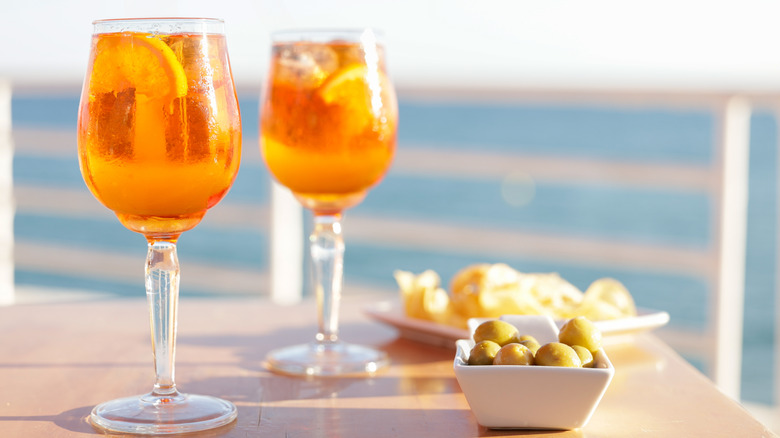How Did Spritz Cocktails Become So Popular?
The spritz cocktail has officially entered its Reigning Cocktail Era. Formerly more of a summertime darling, the spritz ranked as the seventh most sought-after cocktail in the United States in 2023, according to a study from CGA by NIQ. Today, its popularity continues to rise. This wild climb to the top of the cocktail ladder can be attributed to three common themes: the introduction of aperitivo hour, the appeal of lower-alcohol beverages to younger generations, and the adaptability of the spritz's core recipe.
For decades, the spritz — which can be broadly defined as a combination of a bitter element, sparkling wine, and fizzy water — has been a staple in Italian culture. Locals gather for post-work meet-ups to imbibe, share stories, and de-stress. The ritual encourages individuals to slow down after a busy workday, catch up with friends, and savor a low-alcohol drink and some Italian snacks before rushing to dinner. Slowly, the idea of dining like a true Italian has drifted to American shores. As habits around alcohol are changing, bartenders and restaurateurs are pivoting to accommodate them.
Marketing aperitivo hour
The origin story of the spritz cocktail dates back to the early 1800s in Italy's present-day Veneto region — the story goes that Austrian soldiers took to diluting Italian wines with soda water. However, Aperol, one of the leading brands of the bitter, bright-orange aperitif that has become synonymous with a spritz, wasn't exported to the United States until 2006.
Between 2015 and 2016, a widespread shift occurred, as efforts to revolutionize American consumer habits increased — marketing efforts focused on buzzy events, social media influencers, and the fun, bubbly vibe of the drink. There was also a marketing push to accept the culture — and concept — of aperitivo hour, Italy's version of happy hour. New York City's Dante — an early 1900s Italian cafe turned cocktail bar — led the trend by offering an entire menu of spritz-based cocktails.
The entertainment industry followed, and the spritz became central to the second season of HBO's "The White Lotus," which aired in 2022. In August 2024, actress Ashley Park of Netflix's streaming series "Emily in Paris" promoted Aperol in a tennis clothing launch partnership with the U.S. Open. It's no surprise that the Campari Group, which owns the Aperol brand, has increased exports dramatically. For example, 390,000 cases were received stateside in 2022, compared to only 9,000 back in 2010. Today, spritzes are common, taking up notable space on happy hour menus and dinner tables regardless of the time of year.
Spritz cocktails and the sober curious movement
According to a 2020 study from JAMA Pediatrics, from 2002 to 2018, the rate of alcohol abstinence among college students rose 8% while rates among non-college students rose 6.3%. This affirms the trend that young adults, including Gen Zers, continue to consume far less alcohol than previous generations. Many younger adults are motivated by wellness and balanced lifestyles, and they want to avoid or limit common risk factors associated with alcohol consumption.
To illustrate this trend, a study published in 2022 by IWSR Drinks Market Analysis showed that low-alcohol and non-alcoholic drink sales grew 7% in 10 key markets, including in the United States. This rising acceptance of low-alcohol beverages ties right into the significant increase in the popularity of spritz cocktails among sober curious individuals. Compared to hard liquors that generally have around 40% alcohol, Aperol only contains 11% alcohol by volume (ABV). Amante 1530, a newer Italian liqueur brand in the aperitivo category, only has 15% ABV. For conscientious drinkers, ordering a spritz cocktail (or giving your favorite beer the spritz treatment) is a way to enjoy alcohol with a little less buzz.


